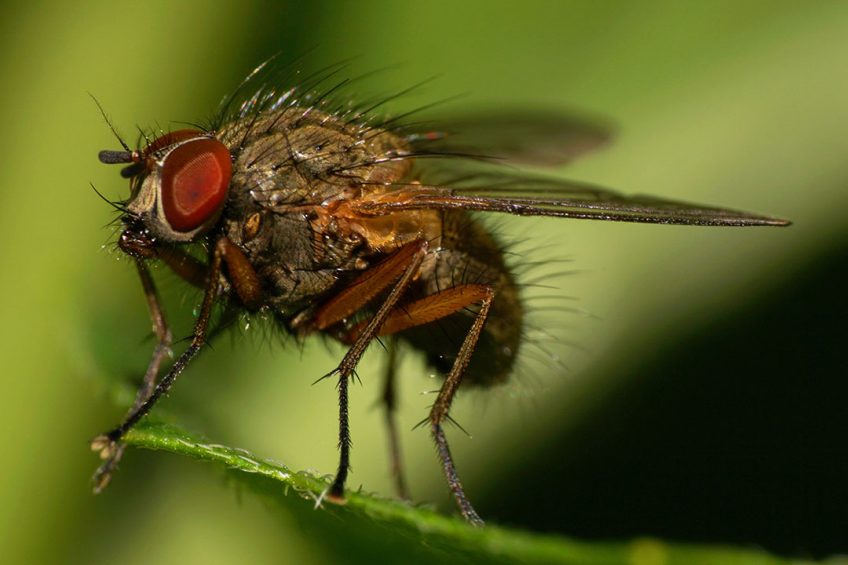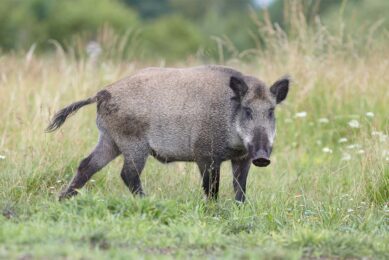Flies can play a role in transmitting ASF into farms

Pigs can in theory get infected with African Swine Fever virus by eating infected flies. Danish researchers reached that conclusion on the basis of trials with stable flies. The outcome could explain ASF outbreaks in the summer on farms applying high biosecurity in e.g. the Baltic states.
Dr Rene Bødker has worked with herds in the Baltic states as well as other countries in Eastern Europe infected with African Swine Fever virus (ASFv). Being associated with the National Veterinary Institute, Technical University of Denmark, for a long time he has been trying to find a pattern in the factors that can influence the infection between herds, to be able to help the non-infected herds to stay free of ASFv. Commonly known is that ASFv spreads by physical contact between pigs or if pigs are being fed with infected food.
In that process, the role of flies intrigued him. He says, “Farms in the Baltic states have a very high biosecurity – many of them higher than for example farms in Denmark. The farms are closed with a fence around them. No trucks with animals, feed and so on are allowed. Recently some of them installed fly filters in the ventilation system to keep out the ASFv-infected flies, but they still got infected with the virus. But flies are difficult to keep out of the stables. One thing pointing towards ASFv-infected flies as vector, is the fact that there seems to be a much higher rate of infection in the summer months.”
That outbreaks apparently occur unpredictably on well-protected farms, this provided more reason for Dr Bødker to suspect the influence of flies. He says, “In all researched countries, populations of ASFv-infected wild boar could be found roaming outside closed farms. The different groups of wild boar are infected by direct contact. But also biting flies are considered to play a role. However, the biting flies do not have a huge living area.”

Flies as mechanical vectors
Blood-feeding horse flies (family Tabanidae) are known to be so-called ‘mechanical vectors’ for viral pathogens. These flies live in semi-aquatic habitats outside farms, where they may have contact with ASFv-infected wild boars before entering the houses containing domestic pigs.
Those flies do not usually live and breed in domestic pig stables. However, the flies are big enough to be chased and eaten by the pigs or accidentally ingested during feeding, should they manage to get inside the pig houses. This might be a way the disease can spread from wild boars to herds and it could also explain large outbreaks in Europe during the summer months.
In order to test that hypothesis, Dr Bødker and his colleagues at the university studied experimental ASFv transmission to pigs via oral uptake of flies, which were previously fed on blood from ASFv-infected pigs.
Infected by eating stable flies with ASFv
The researchers used the smaller stable fly (Stomoxys calcitrans), as a model for blood-feeding flies, as they are readily caught and fed. The transmission experiment showed that a pig easily gets infected with ASFv by eating stable flies fed on ASFv-spiked blood. In total, there were 3 groups with 4 pigs each in the experiment.
• Group 1 was orally inoculated with 1 ml spiked blood, dose 5 log10TCID50. This was a positive control;
• Group 2 was orally inoculated with 20 homogenised flies, dose 5.1-5.3 log10TCID50.
• Group 3 was feed with soft cake containing 20 intact flies;
In group 1, a total of three pigs showed different clinical signs of ASFv (fever, anorexia, depression, convulsions, vomiting and so on) from day 6 to 17. The animals were euthanised at day 9, 15 and 17 after inoculation, respectively. These three pigs also displayed ASFv DNA in the blood. The last pig in group 1 was clinically healthy, but viral DNA was detected in the blood.

In group 2 and 3 in total seven pigs showed clinical signs of ASF from day 5-6 or 11-13. They were euthanised at day 7 and 12-14, respectively. These seven pigs also had viral DNA and infectious ASFv in blood and serum samples.
Only one pig in group 2 and 3 did not show clinical signs of ASF during the trial and did not display ASFv DNA in the blood after the trial. No anti-ASFv antibodies were detected in the serum from any of the 12 pigs. Within each group, the delayed time of infection in some pigs indicate that only 25% (group 1) and 50% (group 2 and 3) of the pigs were infected by the oral ingestion of the virus. The rest of the pigs were most likely infected via contact with the infected animals in their group.
Dose, fly and distance
According to older research in this field, a single fly could carry some 3.8-4.0 log10TCID50, which corresponds to the infectious dose by oral inoculation, when taking into account how much blood S. calcitrans consume, biting an ASFv infectious pig with a blood titre of 5.8 log10TCID50. Weak animals are infected by even lower dose. The Tabanidae can carry up until five times more blood than stable flies, demonstrating a higher risk for the pigs.
Dr Bødker and his team call it unlikely that ingestion of blood-fed flies is a common route for transmission of ASFv between wild boar or between pigs within a stable. They argue, however, that the results indicate that Stomoxys flies could be a possible route of transmission over short distances, while larger flies, such as the Tabanidae, might explain some longer distance examples of ASFv transmission (e.g. from wild boar into farms).

A lab result – not in practice
Commenting on the results, Dr Bødker says, “That pigs can be infected just by eating ASFv-infected flies in the lab, does not necessary mean that this happens easily in herds. The path of infection is influenced by many factors on farms and probably explains the inconsistent spreading of the infection seen between herds in countries with ASFv. New studies are needed to fully understand the path of infection between the pig herds.”
“There could of course also be other pathways for ASFv. We need more research to find the main routes of infection. Until we have a vaccine, which by the way, is not in the pipeline right now and which will be expensive for the farmers, we can solve this problem by other, less expensive management initiatives, this is preferred. For some of the large herds, for example in the Baltic countries and Eastern Europe, where there are wild boar around the herds, you have to consider whether you should make investments to keep the flies out of the stables.”
He concludes, “With the invasion of new or old species of animals – like the wild boar, an increased risk also follows for the husbandry industry being exposed to lethal and costly diseases. This is why the Danish Pig Industry and the Danish authorities decided to build a fence by the German/Danish border to keep the wild boar out. If we keep the wild boar out, we will also keep the ASFv-infected flies out.”
| ASFv can survive three days in stable flies Another study by the Danish researchers, published in Veterinary Microbiology, investigated the role of stable flies in ASFv transmission. Different parts of the flies were analysed for the presence of viral DNA and infectious virus at different time points following in vitro feeding of the flies on blood from an ASFv-infected pig. Using qPCR, ASFv DNA was detectable in mouth parts of flies for at least 12 hours and remained in head and body samples from the flies for up to three days following feeding. They detected infectious virus in fly body samples prepared at three hours and 12 hours after feeding. The presence of infectious ASFv in stable flies following feeding on viraemic blood, means that such flies are capable of transporting infectious virus. |
References available on request.
An article on this subject recently appeared in Transboundary and Emerging Diseases. It was written by Ann Sofie Olesen, Louise Lohse, Mette Frimodt Hansen, Anette Boklund, Tariq Halasa, Graham J. Belsham, Thomas Bruun Rasmussen, Anette Bøtner and René Bødker, all attached to the DTU National Veterinary Institute, Technical University of Denmark, Kongens Lyngby, Denmark.
 Beheer
Beheer








 WP Admin
WP Admin  Bewerk bericht
Bewerk bericht